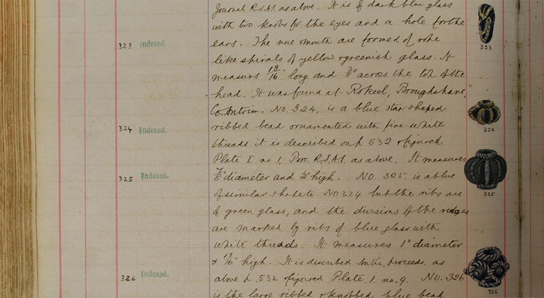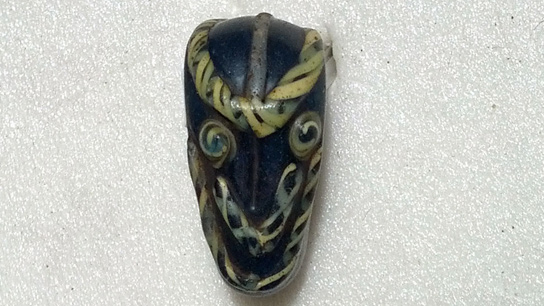Acquired 1908
Glass Cable Beads from Co. Antrim
A collection of unique and beautiful Irish beads from one of Ireland’s most prolific collectors.
The art of collection
A name familiar to anyone who has studied the lithic assemblages of Ireland, William James Knowles was a man of many interests, reflected by his extensive and varied collection. Thousands of objects, documented throughout the Inventory Project, can be traced back to him. Without wishing to divert from the importance of his contribution to the study of Irish lithics, particularly the Mesolithic period, his personal collection of medieval glass beads is certainly a visual highlight.
“1908. Nos. 249 to 351. A collection 105 blotched, scribbled and variously ornamented beads all from Co. Antrim purchased from W. J. Knowles M.R.I.A for £130”
The entire collection is accompanied by detailed colour illustrations that were most likely done by the then Keeper of Antiquities, George Coffey, who was also an accomplished draughtsman. A change in handwriting in the register at the start of 1897 denotes the commencement of his tenure in the Museum. Failing health forced him to leave his post in 1914.
He passed away two years later leaving behind him a large corpus of books and articles which highlight the importance of archaeology and the scientific approach to understanding antiquities. This has remained at the core of the Museum’s ethos, reflected in Ireland’s laws on the discovery of archaeological objects and on the conduct of archaeological excavations.

Style over substance?
Though unquestionably beautiful and valuable, glass beads are unfortunately difficult to date in isolation and therefore are best interpreted when found in the context in an excavation. Many similar types have been found in excavations on crannógs, such as Ballinderry and Lagore, and an early medieval date of c.7th- 10th Century AD can be proposed for these. Before the advent of heritage laws, many of these rare and unique beads found their way out of context and into the display cases of antique dealers, where they could be expected to fetch considerable sums from avid collectors like Knowles.
As he states, “…a choice article is frequently laid aside for me, because it is known that I will not object to a high price if the object is good”. Neither, it seems, would the Museum as it paid the modern equivalent of around £10,000 sterling for the lot of 105 beads.
Imported glass with an Irish twist
At present, there is little evidence for medieval glass manufacture in Ireland. However, sites like Lagore have produced cullet, or scrap glass, that would have originally been made in Anglo-Saxon England or western Europe. As suggested by Nancy Edwards, this scrap glass could have been recycled by Irish craftspeople and used to produce beads like those in the Knowles collection.
The style of decoration found on these beads, featuring several cables of twisted blue and white or blue and yellow glass, is found mostly in Ireland and suggests a native fashion. This was recognised by Hugh O’Neill Hencken, while working on Lagore crannóg. He identified several examples found in Norwegian Viking Age sites as being Irish in origin.
The bead from Rathkeel, Co. Antrim has inventively used a series of applied cables to create the impression of a face. Exactly what kind of face seems to depend on the viewer. Knowles himself thought it might represent an ape, though it was originally described to him as a horse. The most popular interpretation among the Antiquities inventory team is a bearded man so it may have to remain a secret of the artist!

Learn More
This collection of beads is held in the National Museum of Ireland’s reserve collection but there are some similar medieval glass beads and bangle fragments on display in the Viking Ireland exhibition.
To give a face to the name W.J Knowles, see a portrait of him, painted by his daughter Margaret now in the collection of the Ulster Museum.
References
- Edwards, N. (1990). The archaeology of early medieval Ireland. Philadelphia, University of Pennsylvania Press.
- Hencken, H., Price, L., & Start, L. E. (1950). Lagore Crannog: An Irish Royal Residence of the 7th to 10th Centuries A.D. Proceedings of the Royal Irish Academy. Section C: Archaeology, Celtic Studies, History, Linguistics, Literature, Vol. 53 (1950/1951), pp. 1-247.
- Knowles, W. J. (1881). Ancient Irish Beads and Amulets. The Journal of the Royal Historical and Archaeological Association of Ireland, Fourth Series. Vol. 5, No. 47, pp. 522-537
Location:
Glass Cable Beads from Co. Antrim is located at:
In Storage
Previous artefact:
Gaelic Athletic Association Football Rules Book 1888
Next artefact:
